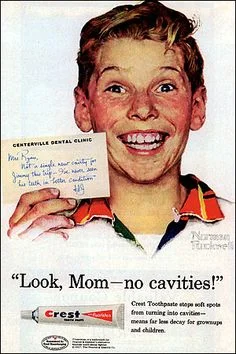Smile, America
“Look at the girl smile!”
by Tess Crain
“Look at the girl smile! The more she smiles, the more certain it is that she represents something trivial, something shocking, or something failed.”
— George W. S. Trow, Within the Context of No Context, 1980
America prizes smiling. Companies in client-facing industries have been known to circulate “service with a smile” policies, which require workers to feign happiness, if necessary, to please customers. “Hey Philly, got a smile only a brother can love?” “Give Us Your Crooked, Crowded, and Snaggled Teeth.” “Come in for a lifetime supply of confidence.” So asks, begs, and pledges SmileDirectClub, one of several fix-your-face startups with pandemic advertising. I understand. I got braces freshman year of high school and did not smile with my mouth open for two years.
A smile can signify differently to different people: “a door that is both open and closed”; “the chosen vehicle of all ambiguities”; breakup schadenfreude. As a constellation of features, manifold signs exist: the split-fruit smile (Julia Roberts, Cameron Diaz); the Cheshire Cat; the manic teeth (Jack Nicholson in The Departed and The Shining); “the smiler with the knife under the cloak.” Tyra Banks claims to have 275 different facial valances, including the Surprised Because Someone Just Gave You a Diamond Ring and You Don’t Know Why Smile. Game of Thrones has gifted us, among others, with I’d Like to Speak to Your Supervisor and I Just Had Sex.
A Duchenne smile (image from Wikipedia).
One smile, however, almost universally signals happiness. Named for the French anatomist Guillaume Duchenne, who studied lineamental displays by electrically stimulating facial muscles (a procedure reportedly so painful for the living that he supplemented with what he could salvage from the guillotine), the “Duchenne smile” triggers both the zygomatic major muscle, tugging the corners of the mouth upward, and the orbicularis oculi muscle, crinkling the eyes.
People are supposedly good at telling apart “genuine” from “fake” smiles. Duchenne believed that only “sweet emotions of the soul” could inspire smizing, so to speak, at least swiftly enough to be convincing. Yet expressions can be practiced and muscles trained. As WikiHow points out in an introduction to “How to Smile Naturally”: “By understanding what makes a real smile, it will be easier for you to fake one.”
In the essay “Within the Context of No Context,” published in 1980 in the New Yorker and later as a book of the same name, George W.S. Trow discusses the perils of “pseudo-cheerfulness,” a particularly American ailment. Acting as though you like things all the time when you do not can be at best “a drain,” as Trow puts it, and at worst the origin of despair. Smiling, generally, bears a history of repression, suppression and oppression. Habitual performance of happiness in the workplace, called “surface acting,” has been linked to increased heavy drinking among a portion of employees. April is the cruelest month because you are expected to enjoy the weather.
Smiling, like gilt, paints a distracting shine over faces that might otherwise belie, for America, “progress achieved”: the tired, the poor, the huddled masses; the oppressed, ill, and abused—the list extends at least from Ellis Island to Waterfront Plaza in Honolulu, HI, where SmileDirectClub has one of its numerous “SmileShops.”
Toward the end of his essay, Trow describes working for the 1964/1965 New York World’s Fair. Despite impressive displays of new technology, the exposition was a costly flop: “People didn’t like the Fair. They tried to like it, though. They agreed to like it…. Not to like it was the same thing as to break the agreement that was all that stood between them and being alone…. The message of many things in America is ‘Like this or die.’”
Although striking, the imperative—repurposed elsewhere—pays for punch at the expense of nuance. Agreeing to like something is not the same as liking it. Used here, the threat of death is hyperbolic, yet the instrumental fear of loneliness felt by Americans was—and is—real. A fuller articulation might be, “Say you like this or die alone.”
Or, put another way: “Smile.”
Tess Crain is a graduate of the NYU Creative Writing Program, where she served as a Goldwater Fellow. Her writing has appeared in the New Republic. She lives in New York City.









